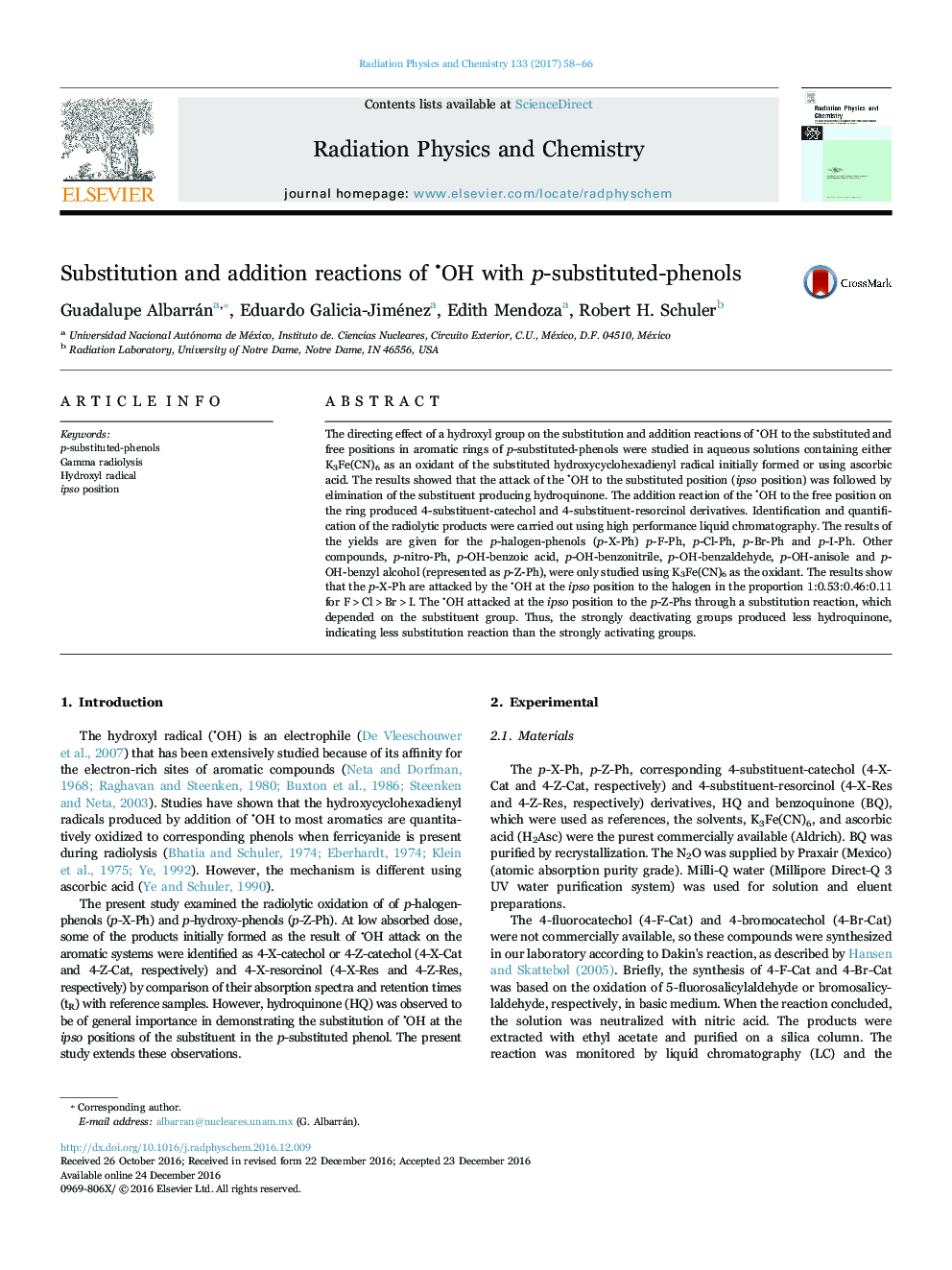| Article ID | Journal | Published Year | Pages | File Type |
|---|---|---|---|---|
| 5499308 | Radiation Physics and Chemistry | 2017 | 9 Pages |
Abstract
The directing effect of a hydroxyl group on the substitution and addition reactions of
- OH to the substituted and free positions in aromatic rings of p-substituted-phenols were studied in aqueous solutions containing either K3Fe(CN)6 as an oxidant of the substituted hydroxycyclohexadienyl radical initially formed or using ascorbic acid. The results showed that the attack of the
- OH to the substituted position (ipso position) was followed by elimination of the substituent producing hydroquinone. The addition reaction of the
- OH to the free position on the ring produced 4-substituent-catechol and 4-substituent-resorcinol derivatives. Identification and quantification of the radiolytic products were carried out using high performance liquid chromatography. The results of the yields are given for the p-halogen-phenols (p-X-Ph) p-F-Ph, p-Cl-Ph, p-Br-Ph and p-I-Ph. Other compounds, p-nitro-Ph, p-OH-benzoic acid, p-OH-benzonitrile, p-OH-benzaldehyde, p-OH-anisole and p-OH-benzyl alcohol (represented as p-Z-Ph), were only studied using K3Fe(CN)6 as the oxidant. The results show that the p-X-Ph are attacked by the
- OH at the ipso position to the halogen in the proportion 1:0.53:0.46:0.11 for F>Cl>Br>I. The
- OH attacked at the ipso position to the p-Z-Phs through a substitution reaction, which depended on the substituent group. Thus, the strongly deactivating groups produced less hydroquinone, indicating less substitution reaction than the strongly activating groups.
- OH to the substituted and free positions in aromatic rings of p-substituted-phenols were studied in aqueous solutions containing either K3Fe(CN)6 as an oxidant of the substituted hydroxycyclohexadienyl radical initially formed or using ascorbic acid. The results showed that the attack of the
- OH to the substituted position (ipso position) was followed by elimination of the substituent producing hydroquinone. The addition reaction of the
- OH to the free position on the ring produced 4-substituent-catechol and 4-substituent-resorcinol derivatives. Identification and quantification of the radiolytic products were carried out using high performance liquid chromatography. The results of the yields are given for the p-halogen-phenols (p-X-Ph) p-F-Ph, p-Cl-Ph, p-Br-Ph and p-I-Ph. Other compounds, p-nitro-Ph, p-OH-benzoic acid, p-OH-benzonitrile, p-OH-benzaldehyde, p-OH-anisole and p-OH-benzyl alcohol (represented as p-Z-Ph), were only studied using K3Fe(CN)6 as the oxidant. The results show that the p-X-Ph are attacked by the
- OH at the ipso position to the halogen in the proportion 1:0.53:0.46:0.11 for F>Cl>Br>I. The
- OH attacked at the ipso position to the p-Z-Phs through a substitution reaction, which depended on the substituent group. Thus, the strongly deactivating groups produced less hydroquinone, indicating less substitution reaction than the strongly activating groups.
Keywords
Related Topics
Physical Sciences and Engineering
Physics and Astronomy
Radiation
Authors
Guadalupe Albarrán, Eduardo Galicia-Jiménez, Edith Mendoza, Robert H. Schuler,
